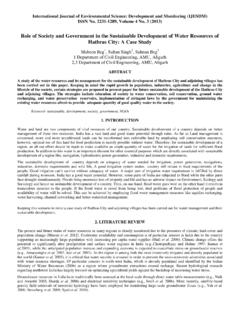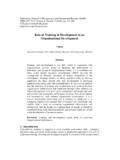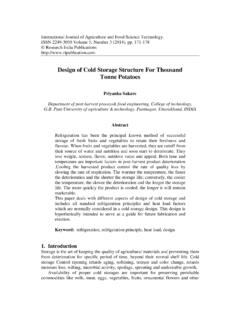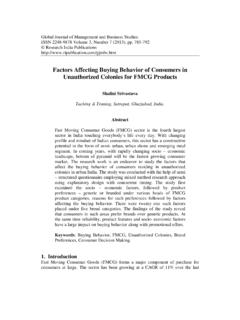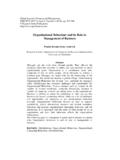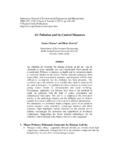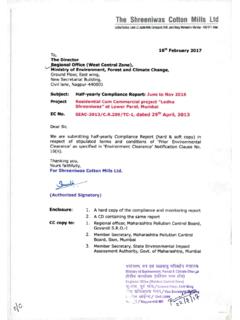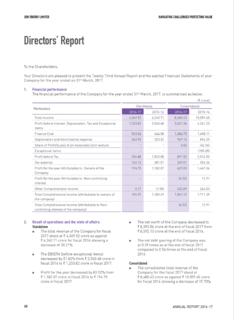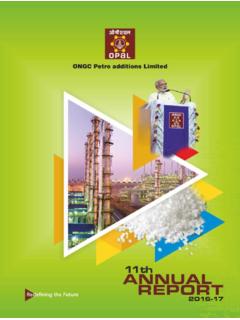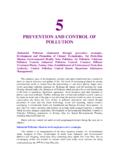Transcription of Sardar Sarovar Dam Controversy- A Case Study
1 Global Journal of Finance and Management. ISSN 0975-6477 Volume 6, Number 9 (2014), pp. 887-892 Research India Publications Sardar Sarovar Dam Controversy- A Case Study Tanmayee Sahoo1, Usha Prakash2 and Mrunmayee M Sahoo3 1 Law Student, LLB, BILS, Bangalore, India 2 Professor, BILS, Bangalore, India 3 Research Student, Dept. of Civil Engg., NIT, Rourkela, India E-mail: Abstract The Sardar Sarovar Dam is a gravity dam on the Narmada River crossing Gujarat in India. It is the largest dam and part of the Narmada Valley Project, a large hydraulic engineering project involving of a series of large irrigation and hydroelectric multi-purpose dams.
2 The project took form in 1979 as part of a development scheme to increase irrigation and produce hydroelectricity. The state governments of Gujarat and Madhya Pradesh claim that the Sardar Sarovar Project (SSP) and the Narmada Sagar Project (NSP) would irrigate million ha and million ha of land and generate 1,450 megawatts (mw) and 1,000 mw of power, respectively. The hydroelectric power of the SSP would be shared by the states of Gujarat, Maharashtra and Madhya Pradesh; the irrigation benefits would accrue to the states of Gujarat and Rajasthan.
3 We recognise the complexity in Sardar Sarovar Valley involved. The questions arise in the dam struggle and the development of the model that holds out the chimerical promise of material wealth. We would emphasise that the water problems of drought prone areas of Gujurat. Recently, the Indian government gave clearance for the construction of the SSP in Gujarat and the NSP in Madhya Pradesh. Keywords: Environment, Gujurat, Irrigation, NSP, SSP. 1. Introduction The Dam on river Narmada was meant for the welfare of four states namely-Gujrat, Madhya Pradesh, Rajasthan and Maharashtra.
4 The agreement of sharing and using Tanmayee Sahoo et al 888water by the four states were defined by the Narmada Water Dispute Tribunal (NWDT) in 1979. Under this award, Gujarat was allocated 11,000 Mm representing about one-third of the 75 percent dependable usable annual water flow, and was authorized to implement a project comprising: (i) the Sardar Sarovar Dam, (ii) a 1,200 megawatt (MW) riverbed powerhouse (RBPH), (iii) a 250 MW canal head powerhouse (CHPH), (iv) a canal system to irrigate m. ha in Gujarat and 70,000 ha in Rajasthan, and (v) a water supply system for about 30 million people in the drought-prone areas of Saurashtra and Kachchh.
5 On this basis, Gujarat prepared the Sardar Sarovar Project in 1980, which was to be implemented in various phases over a period of about 20 years. Phase I comprised of: (i) the Sardar Sarovar Dam, (ii) the RBPH, (iii) the CHPH, (iv) the first 144 km of the main canal up to the Mahi River, and (v) a network of branch and distribution canals and drainage system to irrigate about 450,000 hai. 2. Project Designing The project preparation and organization took a span of four years from identification in the year 1979 to pre- appraisal in 1983.
6 It was completed by Narmada Planning group with assistance from the United Nation Development Program (UNDP). The Narmada Development Department that was in charge of implementing the project had prepared the detail designs and cost estimates of the project. Later in the year may 1988, responsibility for the implementation of the project was transferred from the Narmada Development Department, a government agency, to the Sardar Sarovar Narmada Nigam Ltd. (SSNNL), a parastatal corporation organized along functional lines.
7 The Bank and borrowers reviewed the basic hydrological data used for the project design and gave a satisfactory report. The Narmada Water Dispute tribunal had set the annual 75 percent dependable water availability for the project at 28 million acre feet (MAF) (34,580 Mm ) with percent allocated to Madhya Pradesh, percent to Gujarat. percent to Rajasthan, and percent to Maharashtra project design. The project vested its first priority to water supply, second to irrigation and the last to power generation. As per the original design of the project, the Sardar Sarovar dam was to irrigate lakh ha land in Gujrat and 73,000 ha of land in two districts of Rajasthan.
8 The beneficiary states claimed that in the first phase of command area development, a total of lakh ha land of would be irrigated. At the time of raising the height the height of the dam to m, it was estimated that lakh ha of additional land will be brought under irrigation. 3. Benefits of the project After examining current status of the project on the delivery of benefits as per official data the argument is always in favour of the Sardar Sarovar Project as the benefits are so large that they substantially preponderate over the costs of the immediate human Sardar Sarovar Dam Controversy- A Case Study 889 and environmental disruption.
9 Without the dam, the long term costs for people would be much greater and lack of an income source for future generations would put increasing pressure on the environment. If the waters of the Narmada River continue to flow to the sea unutilized, then there appears to be no alternative to escalating human deprivation, particularly in the dry areas of Gujarat and Rajasthan. The Project has the potential to feed 20 million people, supply domestic and industrial water to 30 million, and provide employment to more than 1 million.
10 Apart from the above benefits it provides valuable peak electricity in areas with high unmet power demand. Gujarat has received Rs 4,887 crores and Rajasthan has received Rs 625 crores under the Accelerated Irrigation Benefit Programme from 1996 to 2008 from the Central Government for the Sardar Sarovar Project (SSP) command area for creation of the canal network which is lagging behind. However the drinking water benefits of the SSP have always been presented as a strong argument in its favor, whenever it was gripped by controversy.
